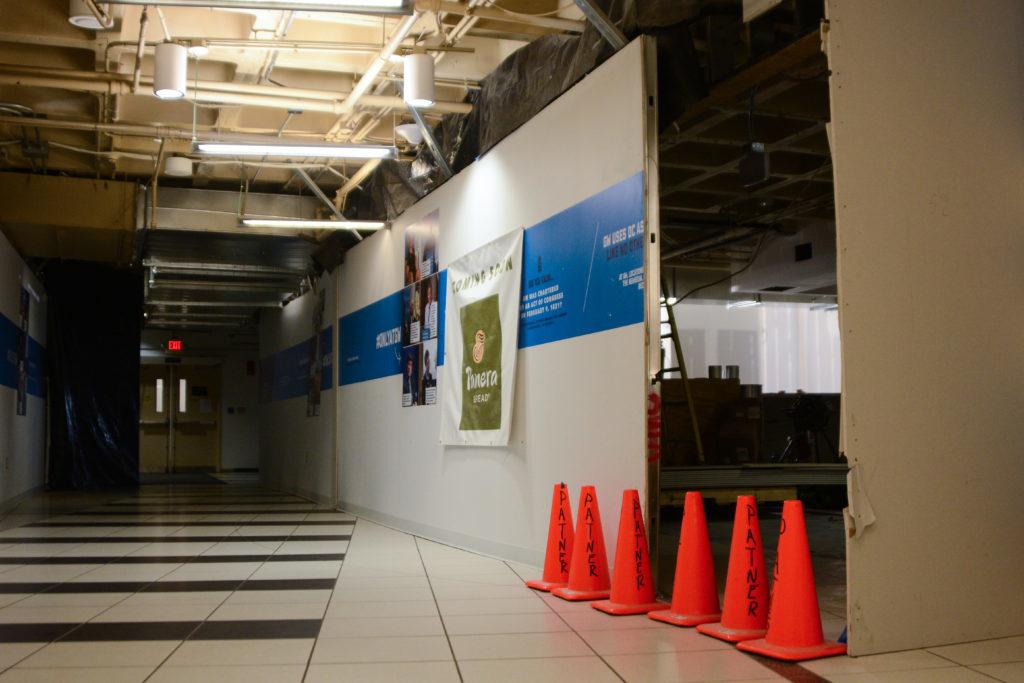The long-awaited renovations to the first floor of the Marvin Center are set to be complete by January, providing students with a new campus hang-out spot in time for the spring semester.
The second phase of the renovations, which will create a “living room” environment on the first floor for students with comfortable furniture, televisions and a conference room, is set to wrap up over winter break, officials said. Officials and student leaders said the space will serve as a spot to study and socialize – finishing off a student-centered hub around H Street that includes Kogan Plaza, Gelman Library and District House.
The first phase of renovations began last January after a push from students for more community spaces on campus.
Tim Miller, the associate dean of students, said the first phase of renovations featured updates to furniture around the Marvin Center and largely “cosmetic” changes that included swapping the cafeteria-style table and chairs for more comfortable furniture. He said the second phase, which began this summer and has blocked off most of the Marvin Center’s first floor from student use, will finish over winter break.
“Some people will be eating, some will be studying, some just gathering – so I really love that balance of lots of different things you can do.”
The space, which was formerly occupied by J Street — the dining hall that shut down in 2016 – will feature a seating area where students can study and socialize and a glassed-in presentation room for use by the admissions office and student groups, officials said.
Panera Bread is set to open opposite of the meeting room, but an opening date has has yet to be announced.
“Some people will be eating, some will be studying, some just gathering – so I really love that balance of lots of different things you can do,” Miller said.
He said the new space is an example of the University acting on student-led campaigns. Former Student Association President Andie Dowd heavily advocated to turn the space into “living room” area during her term and announced the renovation plan in February 2016.
University spokeswoman Maralee Csellar said Ayers Saint Gross, an architectural firm based in Maryland, designed the new space on the first floor, and Patner Construction, a Virginia-based firm, is building and reconstructing the area. She declined to say how much the renovations cost and how the progress of the renovations now compares to the initial plan for the space.
Officials did not initially announce a timeline for the upgrades, but said a budget and timeframe would be determined after the Board of Trustees approved.
The last time the Marvin Center was fully renovated was in 1998, a two-and-a-half-year-long facelift that cost $20 million. Officials added Colonial Crossroads, a collection of student services, to the Marvin Center’s fifth floor in 2012 at a cost of $2 million.
Csellar said the opening date for Panera Bread will be released “sometime prior to the start of the spring semester” and that the floor should be usable “by the start of the spring semester.” When the vendor was first revealed in May, officials said the opening date would likely be announced over the summer. Officials said in August the opening date would be announced during the fall.
Last year, six new vendors in District House faced months of delays before they gradually opened beginning in December 2015.
Csellar said that while the recent openings of District House’s two basement floors and the Science and Engineering Hall’s first floor “have contributed significantly to on-campus spaces for students to socialize and study,” officials recognize how important the Marvin Center is for many student activities.
“The University knows these spaces are highly valued and has worked to expeditiously complete this project,” she said in an email.
Student leaders said the space will facilitate social interactions among students on a congested campus, where student space has long been a contentious issue.
Sydney Nelson, the executive vice president of the SA, said the space will act as an area where students can gather to watch shows or student organizations can host events.
“You just want to present the campus as somewhere where kids have their lunch break.”
“Long term, it’s to make Marvin as much of an inclusive living room-esque vibe as possible,” she said. “We’re going to have programming, so if you want to watch the Super Bowl, you could put that up on the screen and invite students and have food for them and use that as the central location for those more casual programming efforts.”
SA leadership continued to advocate for the space in the years following its announcement, with student leaders sitting in on meetings about the design and use of the space, Nelson said.
Rachel Metz, the president of the Residence Hall Association, said RHA will be more involved in the project after opening dates are announced, helping to promote and advertise the living room and Panera Bread to students.
“You want as many spaces on campus where students can relax and talk and socialize, study,” she said.
Austin Meo, the vice president of RHA, said when he used to give tours for GW two years ago, many parents were concerned about where their children would have space to sit down and eat – a problem the revamped Marvin Center will address.
“You just want to present the campus as somewhere where kids have their lunch break,” he said. “It’s like that traditional campus feel – not a high school cafeteria, but stuff where people have different options.”
Alec D’Angelo, Liz Konneker and Sarah Roach contributed reporting.





